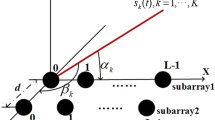Abstract
In this paper, a spiral array is designed to estimate two-dimensional direction of arrival (DOA), which allows a larger spacing between adjacent antennas of the array. The fourth-order cumulant is also utilized to create more virtual antennas, further enlarging the array aperture. The noise resistance of the high-order cumulant can help to construct an improved propagator, and there is no need for any priori knowledge of the source number to estimate the DOAs. With the help of the cumulant, a convex optimization is introduced to improve the estimation accuracy, which can overcome the estimation bias caused by the finite snapshots. Simulation results demonstrate the effectiveness of the proposed estimator.






Similar content being viewed by others
Data Availability
The data used to support the findings of this study are included within the article.
References
T. Ahmed, X. Zhang, W.U. Hassan, A higher-order propagator method for 2D-DOA estimation in massive MIMO systems. IEEE Commun. Lett. 24(3), 543–547 (2020)
J.-F. Cai, E.J. CandRes, Z. Shen, A singular value thresholding algorithm for matrix completion. SIAM J. Optim. 20, 1956–1982 (2010)
H. Chen, W. Zhu, W. Liu, M.N.S. Swamy, Y. Li, Q. Wang, Z. Peng, RARE-based localization for mixed near-field and far-field rectilinear sources. Digital Signal Process. 85, 54–61 (2019)
X. Dai, X. Zhang, Y. Wang, Extended DOA-matrix method for DOA estimation via two parallel linear arrays. IEEE Commun. Lett. 23(11), 1981–1984 (2019)
M. Fu, Z. Zheng, W.-Q. Wang, Y. Liao, Two-dimensional direction of-arrival estimation for cylindrical nested conformal arrays. Signal Process. 179, 107838 (2021)
G. Hua, Y. Dong, W. Hong, Direction of arrival estimation based on logarithm spiral array. Chin. J. Radio Sci. 24(6), 987–991 (2009)
G. Kumar, P. Ponnusamy, Direction finding of coherent sources using three parallel sparse arrays with less computational complexity. Circuits Syst. Signal Process. 40, 4576–4593 (2021)
J. Li, Y. Wang, Z. Ren, X. Gu, M. Yin, Z. Wu, DOA and range estimation using a uniform linear antenna array without a priori knowledge of the source number. IEEE Tran. Antennas Propag. 65(5), 2929–2939 (2021)
S. Marcos, A. Marsal, M. Benidir, The propagator method for source bearing estimation. Signal Process. 42(2), 121–138 (1995)
R. Roy, T. Kailath, ESPRIT-estimation of signal parameters via rotational invariance techniques. IEEE Trans. Acoust. Speech Signal Process. 37(7), 984–995 (1989)
R. Schmidt, Multiple emitter location and signal parameter estimation. IEEE Trans. Antennas Propag. 34(3), 276–280 (1986)
M. Tarkowski, L. Kulas, RSSs-based DOA estimation for ESPAR antennas using support vector machine. IEEE Antennas Wirel. Propag. Lett. 18(4), 561–565 (2019)
L. Xiang, Z. Ye, X. Xu, C. Chang, W. Xu, Y.S. Hung, Direction of arrival estimation for uniform circular array based on fourth-order cumulants in the presence of unknown mutual coupling. IET Microw. Antennas Propag. 2(3), 281–287 (2008)
W. Zeng, X. Li, X. Zhang, Direction-of-arrival estimation based on the joint diagonalization structure of multiple fourth-order cumulant matrices. IEEE Signal Process. Lett. 16(3), 164–167 (2009)
Z. Zheng, Y. Huang, W.-Q. Wang, H.C. So, Augmented covariance matrix reconstruction for DOA estimation using difference coarray. IEEE Trans. Signal Process. 69, 5345–5358 (2021)
Z. Zheng, Y. Huang, W.-Q. Wang, H.C. So, Direction-of-arrival estimation of coherent signals via coprime array interpolation. IEEE Signal Process. Lett. 27, 585–589 (2020)
Z. Zheng, S. Mu, Two-dimensional DOA estimation using two parallel nested arrays. IEEE Commun. Lett. 24(3), 568–571 (2019)
W. Zuo, J. Xin, N. Zheng, A. Sano, Subspace-based localization of far-field and near-field signals without Eigen decomposition. IEEE Trans. Signal Process. 66(17), 4461–4476 (2018)
Acknowledgements
This work was supported in part by Key-Area Research and Development Program of Guangdong Province 2019B010141002, National Natural Science Foundation of China under Grants 62001127, and Guangzhou Municipal Science and Technology Project 202102021077.
Author information
Authors and Affiliations
Corresponding author
Additional information
Publisher's Note
Springer Nature remains neutral with regard to jurisdictional claims in published maps and institutional affiliations.
Rights and permissions
About this article
Cite this article
Li, J., Dai, J., Liang, Z. et al. 2D DOA Estimation Through a Spiral Array Without the Source Number. Circuits Syst Signal Process 41, 3011–3022 (2022). https://doi.org/10.1007/s00034-021-01922-3
Received:
Revised:
Accepted:
Published:
Issue Date:
DOI: https://doi.org/10.1007/s00034-021-01922-3




